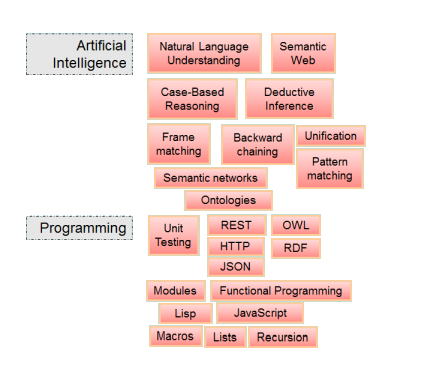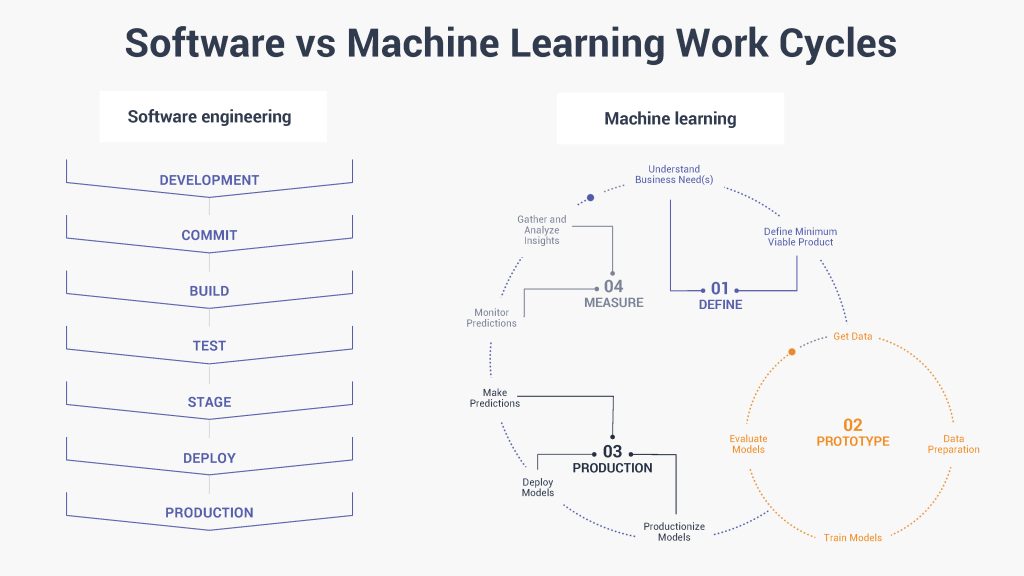All Categories
Featured
Table of Contents
- – Facts About Master's Study Tracks - Duke Elect...
- – Some Known Questions About How To Become A Mac...
- – Fascination About Generative Ai For Software ...
- – Things about Software Engineering Vs Machine ...
- – What Does Ai Engineer Vs. Software Engineer ...
- – How Machine Learning Developer can Save You ...
- – Facts About Top Machine Learning Courses Onl...
Some people believe that that's dishonesty. If somebody else did it, I'm going to use what that person did. I'm forcing myself to assume through the feasible remedies.
Dig a bit deeper in the mathematics at the start, so I can build that structure. Santiago: Lastly, lesson number seven. This is a quote. It claims "You need to understand every detail of an algorithm if you want to utilize it." And after that I say, "I believe this is bullshit guidance." I do not think that you need to understand the nuts and bolts of every algorithm before you utilize it.
I've been utilizing neural networks for the lengthiest time. I do have a feeling of how the gradient descent works. I can not clarify it to you now. I would have to go and inspect back to in fact get a much better instinct. That doesn't imply that I can not address points using neural networks? (29:05) Santiago: Attempting to compel individuals to assume "Well, you're not going to succeed unless you can discuss every detail of just how this functions." It returns to our arranging instance I think that's simply bullshit suggestions.
As an engineer, I've dealt with lots of, many systems and I have actually made use of many, numerous things that I do not comprehend the nuts and screws of how it works, despite the fact that I comprehend the influence that they have. That's the last lesson on that particular string. Alexey: The amusing point is when I think of all these libraries like Scikit-Learn the algorithms they utilize inside to apply, as an example, logistic regression or another thing, are not the like the algorithms we study in equipment learning classes.
Facts About Master's Study Tracks - Duke Electrical & Computer ... Uncovered
So even if we tried to find out to get all these essentials of equipment discovering, at the end, the algorithms that these collections make use of are various. Right? (30:22) Santiago: Yeah, absolutely. I assume we require a great deal a lot more materialism in the sector. Make a whole lot even more of an impact. Or focusing on providing value and a little less of purism.

Incidentally, there are two various courses. I normally speak with those that wish to operate in the industry that desire to have their impact there. There is a course for scientists and that is completely different. I do not risk to discuss that due to the fact that I do not recognize.
But right there outside, in the industry, pragmatism goes a long way for certain. (32:13) Alexey: We had a comment that stated "Really feels more like inspirational speech than chatting concerning transitioning." Perhaps we must switch over. (32:40) Santiago: There you go, yeah. (32:48) Alexey: It is a great motivational speech.
Some Known Questions About How To Become A Machine Learning Engineer & Get Hired ....
One of the things I desired to ask you. Initially, allow's cover a couple of things. Alexey: Allow's start with core tools and frameworks that you require to learn to actually transition.
I understand Java. I understand just how to make use of Git. Possibly I understand Docker.
What are the core tools and structures that I need to discover to do this? (33:10) Santiago: Yeah, definitely. Terrific concern. I think, primary, you need to start finding out a little of Python. Considering that you already recognize Java, I don't assume it's going to be a significant transition for you.
Not because Python is the exact same as Java, however in a week, you're gon na obtain a whole lot of the differences there. Santiago: After that you obtain specific core devices that are going to be utilized throughout your entire occupation.
Fascination About Generative Ai For Software Development
That's a collection on Pandas for information control. And Matplotlib and Seaborn and Plotly. Those 3, or among those three, for charting and showing graphics. After that you get SciKit Learn for the collection of artificial intelligence algorithms. Those are tools that you're mosting likely to have to be using. I do not advise just going and discovering them unexpectedly.
We can talk about specific training courses later. Take one of those programs that are mosting likely to start introducing you to some troubles and to some core concepts of equipment knowing. Santiago: There is a program in Kaggle which is an introduction. I do not bear in mind the name, but if you go to Kaggle, they have tutorials there for cost-free.
What's good concerning it is that the only need for you is to recognize Python. They're going to offer a trouble and inform you how to utilize decision trees to resolve that particular trouble. I believe that procedure is very powerful, since you go from no device finding out background, to comprehending what the trouble is and why you can not solve it with what you understand right now, which is straight software application engineering techniques.
Things about Software Engineering Vs Machine Learning (Updated For ...
On the various other hand, ML engineers concentrate on structure and releasing artificial intelligence designs. They concentrate on training versions with data to make predictions or automate tasks. While there is overlap, AI engineers deal with even more diverse AI applications, while ML engineers have a narrower focus on machine discovering formulas and their practical implementation.

Maker discovering designers concentrate on creating and deploying artificial intelligence designs right into production systems. They function on engineering, guaranteeing designs are scalable, efficient, and incorporated right into applications. On the various other hand, data scientists have a wider function that includes information collection, cleansing, expedition, and structure versions. They are often in charge of drawing out understandings and making data-driven decisions.
As companies significantly take on AI and maker discovering technologies, the demand for experienced experts expands. Equipment learning engineers function on advanced projects, add to technology, and have competitive wages.
ML is fundamentally different from conventional software development as it concentrates on mentor computer systems to gain from information, as opposed to shows explicit regulations that are implemented systematically. Unpredictability of results: You are possibly made use of to composing code with predictable results, whether your function runs when or a thousand times. In ML, however, the results are much less certain.

Pre-training and fine-tuning: Just how these versions are trained on substantial datasets and after that fine-tuned for particular jobs. Applications of LLMs: Such as message generation, sentiment evaluation and info search and access.
What Does Ai Engineer Vs. Software Engineer - Jellyfish Mean?
The capability to manage codebases, combine adjustments, and resolve conflicts is just as important in ML growth as it is in traditional software jobs. The skills established in debugging and screening software program applications are extremely transferable. While the context could change from debugging application logic to determining problems in data handling or version training the underlying concepts of systematic examination, theory screening, and iterative refinement coincide.
Maker understanding, at its core, is greatly reliant on stats and chance concept. These are vital for understanding just how algorithms discover from information, make predictions, and review their performance.
For those interested in LLMs, an extensive understanding of deep learning designs is beneficial. This includes not only the technicians of semantic networks but also the architecture of certain versions for various usage cases, like CNNs (Convolutional Neural Networks) for image processing and RNNs (Recurrent Neural Networks) and transformers for sequential information and all-natural language handling.
You need to recognize these problems and find out methods for identifying, reducing, and interacting regarding bias in ML designs. This consists of the prospective effect of automated choices and the ethical ramifications. Several designs, specifically LLMs, require considerable computational sources that are often offered by cloud systems like AWS, Google Cloud, and Azure.
Building these skills will not only assist in a successful change into ML yet likewise guarantee that programmers can add successfully and responsibly to the development of this dynamic field. Theory is important, yet absolutely nothing beats hands-on experience. Begin dealing with projects that allow you to apply what you have actually discovered in a useful context.
Take part in competitors: Sign up with systems like Kaggle to take part in NLP competitions. Construct your tasks: Begin with straightforward applications, such as a chatbot or a text summarization tool, and gradually raise intricacy. The field of ML and LLMs is rapidly advancing, with brand-new breakthroughs and modern technologies emerging regularly. Remaining updated with the latest research study and trends is crucial.
How Machine Learning Developer can Save You Time, Stress, and Money.
Contribute to open-source projects or write blog site messages about your discovering trip and projects. As you gain proficiency, start looking for possibilities to include ML and LLMs into your job, or seek brand-new roles focused on these innovations.

Potential usage instances in interactive software application, such as referral systems and automated decision-making. Recognizing uncertainty, standard analytical measures, and likelihood distributions. Vectors, matrices, and their function in ML algorithms. Mistake reduction strategies and gradient descent explained simply. Terms like version, dataset, features, tags, training, reasoning, and recognition. Information collection, preprocessing methods, version training, assessment processes, and deployment factors to consider.
Decision Trees and Random Forests: User-friendly and interpretable versions. Support Vector Machines: Maximum margin category. Matching problem types with suitable designs. Stabilizing performance and complexity. Fundamental framework of semantic networks: nerve cells, layers, activation functions. Split computation and onward breeding. Feedforward Networks, Convolutional Neural Networks (CNNs), Recurrent Neural Networks (RNNs). Image acknowledgment, sequence prediction, and time-series evaluation.
Constant Integration/Continuous Deployment (CI/CD) for ML process. Model tracking, versioning, and efficiency monitoring. Discovering and addressing adjustments in model efficiency over time.
Facts About Top Machine Learning Courses Online Revealed

Course OverviewMachine discovering is the future for the future generation of software professionals. This training course works as an overview to artificial intelligence for software designers. You'll be introduced to three of one of the most appropriate components of the AI/ML discipline; monitored discovering, neural networks, and deep knowing. You'll realize the differences between standard shows and device learning by hands-on development in monitored learning before constructing out complicated dispersed applications with semantic networks.
This course works as an overview to machine lear ... Program Extra.
Table of Contents
- – Facts About Master's Study Tracks - Duke Elect...
- – Some Known Questions About How To Become A Mac...
- – Fascination About Generative Ai For Software ...
- – Things about Software Engineering Vs Machine ...
- – What Does Ai Engineer Vs. Software Engineer ...
- – How Machine Learning Developer can Save You ...
- – Facts About Top Machine Learning Courses Onl...
Latest Posts
How To Optimize Your Resume For Faang Software Engineering Jobs
Best Software Engineering Interview Prep Courses In 2025
Director Of Software Engineering – Common Interview Questions & Answers
More
Latest Posts
How To Optimize Your Resume For Faang Software Engineering Jobs
Best Software Engineering Interview Prep Courses In 2025
Director Of Software Engineering – Common Interview Questions & Answers